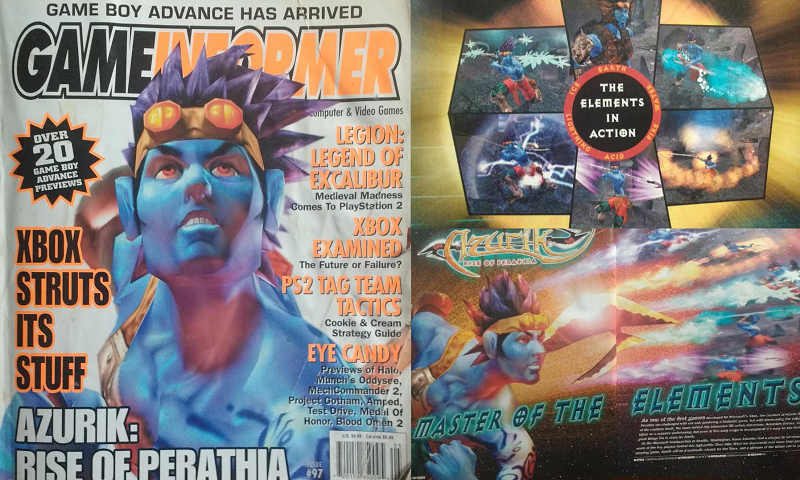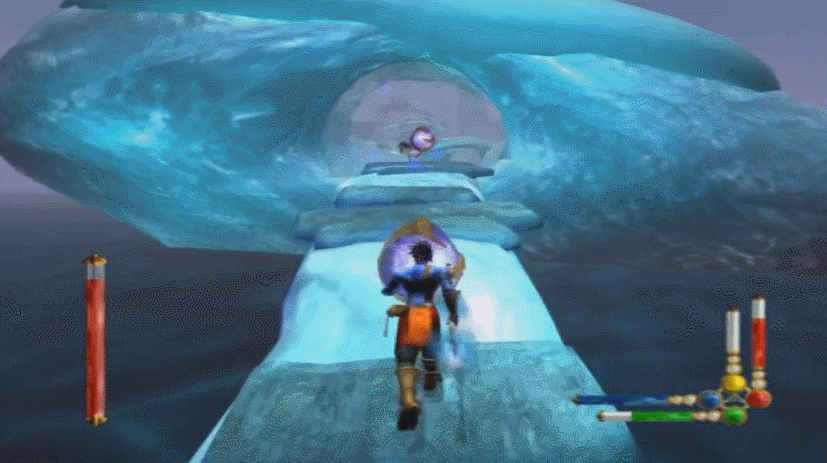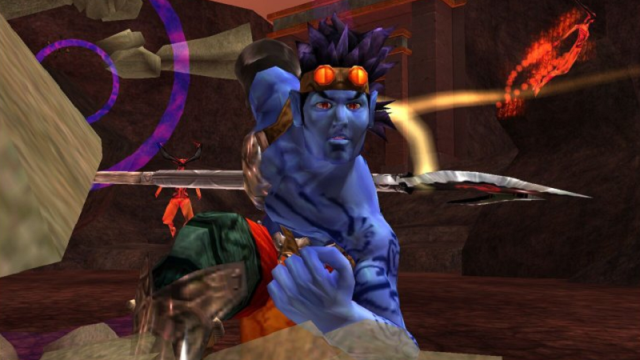Image via Games Asylum
Azurik: Rise of Perathia came out within two weeks of the first Xbox’s US launch back in November of 2001 (Australia got the Xbox in March the next year). It was supposed to be Microsoft’s interpretation of Mario meets Zelda, showing off what the new system could do and creating a iconic dynasty in the process. Instead, the blue-skinned stud rocking Goku hair and goggles turned out to be even more forgettable than Gex.
Hyped for months leading up to the new hardware’s release, the game was promptly met with a combination of frustration and bewilderment, two reactions that eventually gave way to apathy. The once exciting new platformer for Microsoft’s first-ever console was, in the blink of an eye, reduced to a few whispers scattered across the occasional forum post and garage sale.

The game’s cover story in the pages of Game Informer from May of 2001 spanned eight pages.
As late as 2001, people still seemed to think new video game consoles needed mascots. Nintendo had Mario, Sega created Sonic and even PlayStation tried to brand itself with the furry antics of Crash Bandicoot for several years and three entire games. Since Halo’s Master Chief was best known for both shooting other things in the face and never actually showing his own, people looked elsewhere for an Xbox icon. For a brief period of time between when the game was announced and when it eventually flopped, they found it in the titular hero of Azurik.
But what exactly went wrong with Adrenium Games’ Azurik is perhaps a bit more complicated. The game’s muddy textures and flat, grey skyboxes certainly didn’t do it any favours. Halo: Combat Evolved came out just slightly before it, making Azurik look dated by comparison despite both games looking on par with Ocarina of Time, a game three years their senior. It’s hard to imagine, but The Wind Waker was released only a year after this:
In retrospect though, there’s something captivating about the game’s vast, repetitive spaces. Some of the best games do a wonderful job of helping you forget that you’re wandering around a digital abyss. I’m not riding Epona across a pile of textures in Ocarina of Time, I’m exploring the fields of Hyrule; I’m not firing pixels at other pixels in Fallout 3, I’m fighting for survival in a radioactive hellscape.
Azurik wears its artifice on its sleeve, however. Not by design, of course, but the effect is equal parts haunting and blissful all the same. And compared to the polished games of today, chock-full of collectables, so densely populated they’re practically bursting at the seams, I can’t help but look back at Azurik’s sharp edges and tranquil vacancies with a slight pang of longing. Its world was simple and straightforward, broken up into different elemental zones like ice and fire which substituted bright colours and simple forms for logic and environmental coherence. It’s as if the creators of Azurik tried to build the game based off of half-remembered scenes from a shared dream they once had. They captured the broad emotional strokes of the experience but the details tying it together proved to elusive.

In some respects, Azurik gave a clue to the eventual popularity of niche art-playgrounds like Proteus and Dear Esther. Even at the time, people had some idea of how ambitious and beautiful the vision for the game’s world was. Absent the clumsy controls and contrived plot, the game might have re-emerged years after release as a testament to letting the player flail around in strange, directionless vistas as they searched in vain for some sign of the developer’s secret intentions.
Composer Jeremy Soule’s lushly orchestrated soundtrack for the game only complicates its unique non-legacy. Soule, who created the music for games like Secret of Evermore and Oblivion, knows his way around the string section like a fine chef surveying what’s on offer at the local market, and Azurik is no exception. Sometimes subtle and intimate, sometimes majestic and sweeping, the game’s best tracks have more in common with something by John Williams than most other video game music. Clearly head and shoulders above the game itself in terms of its quality and polished artistry, the contrast Soule’s music for Azurik cuts with the game itself is a sublime reminder of just how far short Adrenium Games’ creation fell of their creative aspirations.
In Volume 1 of the Encyclopedia of Video Games, edited by Mark J.P. Wolf, Azurik is mentioned only once, in passing, as a symbol of the Xbox’s mostly uninspired launch line-up. This is another way of saying that there is little lasting record of the game beyond some Let’s Plays on YouTube and a few disinterested reviews. In this way they’re like the weird puzzles and enemies strewn about the world of Perathia: Evidence more of what might have been than what actually was.

Comments
4 responses to “Happy Birthday To The Original Xbox’s First Unofficial Mascot ”
I may be in the minority here but I absolutely loved this game when it came out.
I had a lot of fun with Azurik too. It’s not half as bad as it’s made out to be. It’s definitely no AAA, god-tier title, but you can get it for next to nothing (like most of the OG Xbox library) and have a good time with it.
How exactly was Halo’s graphics on par with Ocarina’s?
I Love Ocarina to bits, though Halo was perfect equation for next gen success.
Best next gen experience I’ve ever had by far
Yeah. Halo is considerably better looking and has much bigger environments than Ocarina.